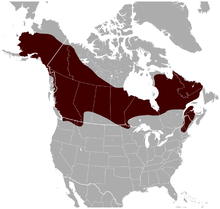Northern bog lemming: Difference between revisions
Lead binomial to bold italic |
category for author, some overcategorization |
||
| Line 12: | Line 12: | ||
}} |
}} |
||
The '''northern bog lemming''' ('''''Synaptomys borealis''''') is a small [[North America]]n [[lemming]]. It is one of two species in the genus ''Synaptomys'', the other being the [[southern bog lemming]]. |
The '''northern bog lemming''' ('''''Synaptomys borealis''''') is a small [[North America]]n [[lemming]]. It is one of two species in the genus ''Synaptomys'', the other being the [[southern bog lemming]]. It is sometimes placed in its own genus, ''[[Mictomys]]''. |
||
==Description== |
==Description== |
||
| Line 35: | Line 35: | ||
[[Category:Rodents of North America]] |
[[Category:Rodents of North America]] |
||
[[Category:Mammals of Canada]] |
[[Category:Mammals of Canada]] |
||
[[Category:Mammals of the United States]] |
|||
[[Category:Fauna of Alaska]] |
[[Category:Fauna of Alaska]] |
||
[[Category:Fauna of the Northwestern United States]] |
[[Category:Fauna of the Northwestern United States]] |
||
[[Category:Mammals described in 1828]] |
[[Category:Mammals described in 1828]] |
||
[[Category:Least concern biota of North America]] |
|||
[[Category:Least concern biota of the United States]] |
[[Category:Least concern biota of the United States]] |
||
[[Category:Taxa named by John Richardson (naturalist)]] |
|||
Revision as of 21:58, 10 March 2024
| Northern bog lemming | |
|---|---|
| Scientific classification | |
| Domain: | Eukaryota |
| Kingdom: | Animalia |
| Phylum: | Chordata |
| Class: | Mammalia |
| Order: | Rodentia |
| Family: | Cricetidae |
| Subfamily: | Arvicolinae |
| Genus: | Synaptomys |
| Species: | S. borealis
|
| Binomial name | |
| Synaptomys borealis (Richardson, 1828)
| |

| |
| Northern bog lemming range[2] | |
The northern bog lemming (Synaptomys borealis) is a small North American lemming. It is one of two species in the genus Synaptomys, the other being the southern bog lemming. It is sometimes placed in its own genus, Mictomys.
Description
They have cylindrical bodies covered with long grey or brown fur with pale grey underparts. A patch of rust-coloured hair is seen at the base of the ears. They have small eyes, a hairy snout, and a short tail. They have 16 teeth and their upper incisors are grooved. They are 13 cm long with a 2-cm tail, and weigh about 30 g.
Distribution and habitat
These animals are found in wet northern forests, bogs, tundra, and meadows in Canada, Alaska, northern Washington, Minnesota, and New England. They feed on grasses, sedges, other green vegetation, and mosses, as well as snails and slugs. Their droppings are green. Predators include owls, hawks, mustelids, and snakes. They are listed as "Species of Special Concern" for protection and preservation by the State of Minnesota [3]
Breeding
Female lemmings have two or three litters of four to six young in a year. The young are born in a nest in a burrow or concealed in vegetation.
Behaviour
They are active year-round, day and night. They make runways through the surface vegetation, and also dig burrows. They burrow under the snow in winter. These animals are often found in small colonies. Lemming populations go through a 3- or 4-year cycle of boom and bust.
References
- ^ Cassola, F. (2017). "Synaptomys borealis". IUCN Red List of Threatened Species. 2017: e.T42638A22377185. doi:10.2305/IUCN.UK.2017-2.RLTS.T42638A22377185.en. Retrieved 18 November 2021.
- ^ IUCN (International Union for Conservation of Nature) 2008. Synaptomys borealis. In: IUCN 2014. The IUCN Red List of Threatened Species. Version 2014.3. http://www.iucnredlist.org. Downloaded on 21 March 2015.
- ^ "List of Species in Greatest Conservation Need (SGCN)" (PDF). MNSGCN.

